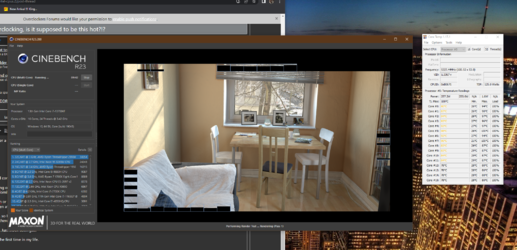- Joined
- Apr 20, 2009
I recently finished putting together a new rig.
Intel 13700kf
Gigabyte z790 Arous Elite
32gb G-Skill
2tb m.2
Gigabyte 4090 Gaming OC
The 4090 is a HUGE graphics card compared to my previous 2080ti, it barely fits in the case. Also I used a piece of PVC as a 'anti-sag' brace.
I've spent the last few days working on mounting fans and finishing up the install.
I've been running CoreTemp randomly throughout the reboots to see if my Noctua NH-D15 is sat properly and from the idle temps, I thought I had a pretty good seating.
But as soon as I put on CineBench or Prime95 the temperatures jump almost instantly into the 85-100 degree range.
Also the temperatures are not even at all, there is alot of variation between them.
I've never had a CPU got this hot, so I resat the heatsink, thinking the thermal grease was spread in a bad way, but after the 2 reseats the temperatures are still crazy high, and the speed at which they get there is almost instant, no build up like past processors. Its like the heatsink isn't there at all.
And this is WITHOUT a overclock. Just stock settings....
I think I am hitting Tjunction for the first time in my life.

Whats going on here?
Are the Raptor Lakes just this hot?
The only difference between this and my other rigs, is I tried mounting the heatsink horizontal this time (blowing air up instead of at the back of the case).
But the seating seems good, I don't think that is the issue.
Intel 13700kf
Gigabyte z790 Arous Elite
32gb G-Skill
2tb m.2
Gigabyte 4090 Gaming OC
The 4090 is a HUGE graphics card compared to my previous 2080ti, it barely fits in the case. Also I used a piece of PVC as a 'anti-sag' brace.
I've spent the last few days working on mounting fans and finishing up the install.
I've been running CoreTemp randomly throughout the reboots to see if my Noctua NH-D15 is sat properly and from the idle temps, I thought I had a pretty good seating.
But as soon as I put on CineBench or Prime95 the temperatures jump almost instantly into the 85-100 degree range.
Also the temperatures are not even at all, there is alot of variation between them.
I've never had a CPU got this hot, so I resat the heatsink, thinking the thermal grease was spread in a bad way, but after the 2 reseats the temperatures are still crazy high, and the speed at which they get there is almost instant, no build up like past processors. Its like the heatsink isn't there at all.
And this is WITHOUT a overclock. Just stock settings....
I think I am hitting Tjunction for the first time in my life.

Whats going on here?
Are the Raptor Lakes just this hot?
The only difference between this and my other rigs, is I tried mounting the heatsink horizontal this time (blowing air up instead of at the back of the case).
But the seating seems good, I don't think that is the issue.